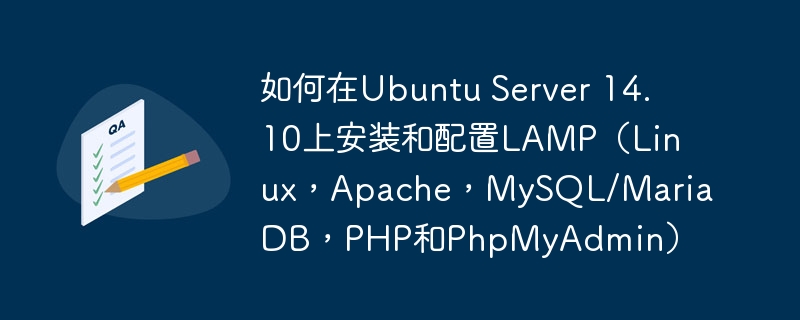

Setting up LAMP (Linux, Apache, MySQL/MariaDB, PHP and PhpMyAdmin) in Ubuntu Server 14.10 includes installing and configuring a working web development stack. LAMP provides a complete environment for developing and deploying dynamic websites and web applications.
Linux, as a running system, provides a strong and stable foundation for the entire stack. Apache acts as a web server, managing incoming requests and serving web pages. MySQL/MariaDB is a relational database management system used to store and process data. PHP is a scripting language used for dynamic content generation. Additionally, PhpMyAdmin serves as a complete web-based management tool for handling MySQL and MariaDB databases. It provides a user-friendly interface for executing SQL queries, handling database users and performing other database-related tasks.
Setting up LAMP on Ubuntu Server 14.10 includes installing the necessary packages, configuring Apache to serve PHP files, installing the MySQL/MariaDB database, and securing the installation. Once set up, developers can use the LAMP stack to create and install dynamic websites and programs.
Manual installation
Use Tasksel
These instructions demonstrate how to manually set up a LAMP stack including Linux, Apache, MySQL/MariaDB, PHP, and PhpMyAdmin, on Ubuntu Server 14.10. Ubuntu Server 14.10 should be installed and updated. Using a package manager, install MariaDB/MySQL after installing Apache, then set a password to protect it. Place PHP and required modules. PHP files should be processed by Apache. In order to make the database available via the Internet interface, set up PhpMyAdmin. Restart the server after installing Apache to provide access to PhpMyAdmin. As of now, your Ubuntu Server 14.10 is ready with a fully functional LAMP stack that can host websites and manage databases.
Update the operating system and install Ubuntu Server 14.10.
sudo apt update sudo apt upgrade
Set up Apache as a web server to handle incoming web page requests.
sudo apt install apache2 sudo systemctl start apache2 sudo systemctl enable apache2
As the next step, provide the password and configure the database.
sudo apt install mysql-server sudo mysql_secure_installation
Install PHP and the corresponding required modules to support building dynamic websites. Additionally, use the following prompt command to install through the terminal.
sudo apt install php libapache2-mod-php php-mysql
Modify the configuration file to configure Apache to process PHP files.
sudo nano /etc/apache2/apache2.conf sudo systemctl restart apache2
Set up PhpMyAdmin, a web application for efficient database management.
sudo apt install phpmyadmin
Modify Apache's settings to provide PhpMyAdmin access.
sudo nano /etc/apache2/conf-available/phpmyadmin.conf sudo ln -s /etc/apache2/conf-available/phpmyadmin.conf /etc/apache2/conf-enabled/phpmyadmin.conf
Restart the application so that all changes can stabilize.
sudo systemctl restart apache2
Use Tasksel to build LAMP stacks (Linux, Apache, MySQL/MariaDB, PHP and PhpMyAdmin) on Ubuntu Server 14.10. First install the Ubuntu Server 14.10 operating system. Then install Tasksel using your package manager. Run Tasksel and select the LAMP server option in the third step. In the fourth step, Tasksel will help you complete the installation process by automatically setting up Apache, MySQL/MariaDB, PHP, and PhpMyAdmin. Finally, follow any additional instructions or configuration provided by Tasksel. By automating the installation and configuration of the complete LAMP stack, this technology makes the setup process simple and convenient for users with little experience or time to spare.
Get started by getting the Ubuntu Server 14.10 model and following the setup prompts.
Once the server installation is complete, use the package manager to replace the gadget by running the command "sudo apt-get update" to ensure you have the latest package information.
Use the package manager to install the Tasksel tool, which simplifies the installation process of software packages, by running the following command.
"sudo apt-get deploying tasksel".
Start Tasksel by executing the command "sudo tasksel".
Tasksel will display a list of available software program options. Please review the list to choose a LAMP server option.
Consumers are prompted to select a LAMP server option by entering the corresponding number or selecting using the arrow keys and pressing Enter.
If the consumer selected the LAMP server option, proceed to step 9. Otherwise, use Tasksel and the algorithm to exit.
Install Apache because the Internet server side uses the package manager through the command "sudo apt-get deploy apache2".
Install MySQL/MariaDB because the database control tool needs to run the command "sudo apt-get deploy mysql-server".
Install PHP and specified add-ons required for integration with Apache and MySQL/MariaDB. Use the package manager by running the command "sudo apt-get install PHP libapache2-mod-PHP PHP-mysql".
Configure Apache to process PHP documents by enhancing the configuration report to include usage with a text editor. This report can usually be found at "/etc/apache2/mods-enabled/dir.conf". Make sure PHP modules are indexed before other modules.
Use the package manager to install PhpMyAdmin, a web-based database management tool by running the command "sudo apt-get install phpmyadmin".
During the setup process, you may need to configure PhpMyAdmin for use with an Internet server - select Apache and follow the prompts.
Follow any subsequent configuration commands provided during the installation process to properly install PhpMyAdmin.
Apply the adjustments made to the Apache configuration by restarting the Apache internet server using the command "sudo systemctl restart apache2".
LAMP stack setup is now complete. You can access an Internet server by entering the server's IP address into your web browser. To access PhpMyAdmin, visit "http://server_ip/phpmyadmin" and log in using your MySQL or MariaDB credentials.
In summary, setting up a LAMP stack on Ubuntu Server 14.10 requires installing and setting up the necessary components. Manual installation technology provides great flexibility and control by allowing users to independently install and configure Apache, MySQL/MariaDB, PHP and PhpMyAdmin. However, for newbies or those looking for simplicity, using Tasksel provides a more automated and streamlined process. Either way, after successfully installing the LAMP stack, Ubuntu Server 14.10 becomes a powerful platform for hosting websites and managing databases efficiently.
The above is the detailed content of How to install and configure LAMP (Linux, Apache, MySQL/MariaDB, PHP and PhpMyAdmin) on Ubuntu Server 14.10. For more information, please follow other related articles on the PHP Chinese website!




